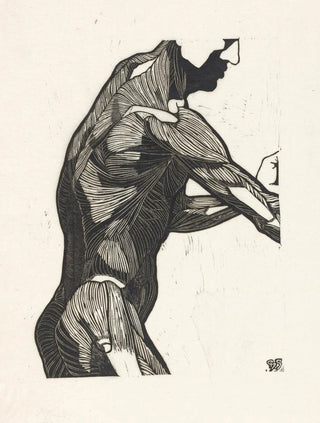Art print | Anatomical study of the lateral muscles and arms of a man - Reijer Stolk


View from behind

Frame (optional)
The artwork "Anatomical Study of the Lateral Muscles and Arms of a Man" by Reijer Stolk is a true invitation to delve into the fascinating world of artistic anatomy. This study, which combines scientific precision with aesthetic sensitivity, reflects the obsession of Renaissance artists and early modern masters with the faithful representation of the human body. Stolk, as an artist, does not merely reproduce forms; he seeks to capture the very essence of life through meticulous analysis of musculature. This piece, with its depth and rigor, becomes a bridge between art and science—a visual exploration that captivates and provokes thought.
Style and uniqueness of the work
The uniqueness of this study lies in how Stolk approaches the depiction of muscles. Every line, every shadow is carefully placed to suggest movement and vitality. Stolk's style is distinguished by an almost surgical precision, revealing not only the anatomical structure but also the inherent beauty of it. The details, whether fine or bold, are executed with such mastery that the work seems to vibrate with its own energy. This approach, blending scientific accuracy with artistic sensitivity, makes this study a masterpiece in its own right, where the human body becomes a terrain for aesthetic and intellectual exploration.
The artist and his influence
Reijer Stolk, although less known than other masters of his time, has left an indelible mark in the world of anatomical art. His ability to fuse art and science has inspired many artists and scientists who followed in his footsteps. By studying the human body with such rigor, Stolk contributed to the understanding of anatomy while providing artists with reference models for their own creations. His influence is evident in how contemporary artists approach the depiction of the body, often blending traditional techniques with modern innovations. Stolk's passion for anatomy, coupled with his talent, allowed him to transcend mere anatomical studies to create works of art in their own right, demonstrating

Matte finish

View from behind

Frame (optional)
The artwork "Anatomical Study of the Lateral Muscles and Arms of a Man" by Reijer Stolk is a true invitation to delve into the fascinating world of artistic anatomy. This study, which combines scientific precision with aesthetic sensitivity, reflects the obsession of Renaissance artists and early modern masters with the faithful representation of the human body. Stolk, as an artist, does not merely reproduce forms; he seeks to capture the very essence of life through meticulous analysis of musculature. This piece, with its depth and rigor, becomes a bridge between art and science—a visual exploration that captivates and provokes thought.
Style and uniqueness of the work
The uniqueness of this study lies in how Stolk approaches the depiction of muscles. Every line, every shadow is carefully placed to suggest movement and vitality. Stolk's style is distinguished by an almost surgical precision, revealing not only the anatomical structure but also the inherent beauty of it. The details, whether fine or bold, are executed with such mastery that the work seems to vibrate with its own energy. This approach, blending scientific accuracy with artistic sensitivity, makes this study a masterpiece in its own right, where the human body becomes a terrain for aesthetic and intellectual exploration.
The artist and his influence
Reijer Stolk, although less known than other masters of his time, has left an indelible mark in the world of anatomical art. His ability to fuse art and science has inspired many artists and scientists who followed in his footsteps. By studying the human body with such rigor, Stolk contributed to the understanding of anatomy while providing artists with reference models for their own creations. His influence is evident in how contemporary artists approach the depiction of the body, often blending traditional techniques with modern innovations. Stolk's passion for anatomy, coupled with his talent, allowed him to transcend mere anatomical studies to create works of art in their own right, demonstrating






